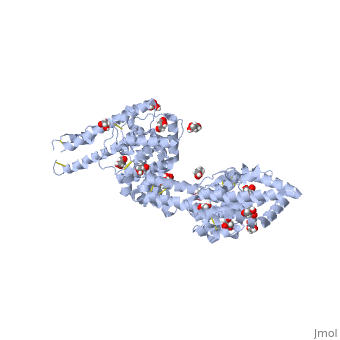From Proteopedia
proteopedia linkproteopedia link Introduction
In 2010, malaria caused over 650,000 deaths.[1] While this disease is both preventable and curable, many of those that live in areas where the disease is endemic do not have access to such resources. Although there is a vaccine currently undergoing clinical trials, results are not expected until 2014.[1] The most recent vaccine research has focused on understanding a group of proteins in the erythrocyte-binding ligand (EBL) family. These proteins, which are found in the Plasmodium species, facilitate entry into erythrocytes during malarial infection by creating tight junctions between the host erythrocytes and parasite membranes. [2] There are four family members: erythrocyte-binding antigen 175 (PfEBA-175), erythrocyte-binding ligand 1 (PfEBL-1), erythrocyte-binding antigen 140 (PfEBA-140), and erythrocyte-binding antigen 181 (PfEBA-181).[2] PfEBA-140 binds glycophorin C on host erythrocytes.[2] Understanding the mechanism by which PfEBA-140 recognizes and engages glycophorin C on erythrocytes may lead to the future development of a new malaria vaccine.
General Structure
| The EBL family members, including PfEBA-140, are made up of two regions, region II (RII) (shown to the right) and region VI.[2] Region II is responsible for receptor binding in all EBL family members.[2] RII is composed of two Duffy binding-like (DBL) domains, F1 and F2.
|
References
- ↑ 1.0 1.1 http://www.who.int/mediacentre/factsheets/fs094/en/index.html
- ↑ 2.0 2.1 2.2 2.3 2.4 Lin DH, Malpede BM, Batchelor JD, Tolia NH. Crystal and Solution Structures of Plasmodium falciparum Erythrocyte-binding Antigen 140 Reveal Determinants of Receptor Specificity during Erythrocyte Invasion. J Biol Chem. 2012 Oct 26;287(44):36830-6. doi: 10.1074/jbc.M112.409276. Epub 2012, Sep 18. PMID:22989878 doi:10.1074/jbc.M112.409276

